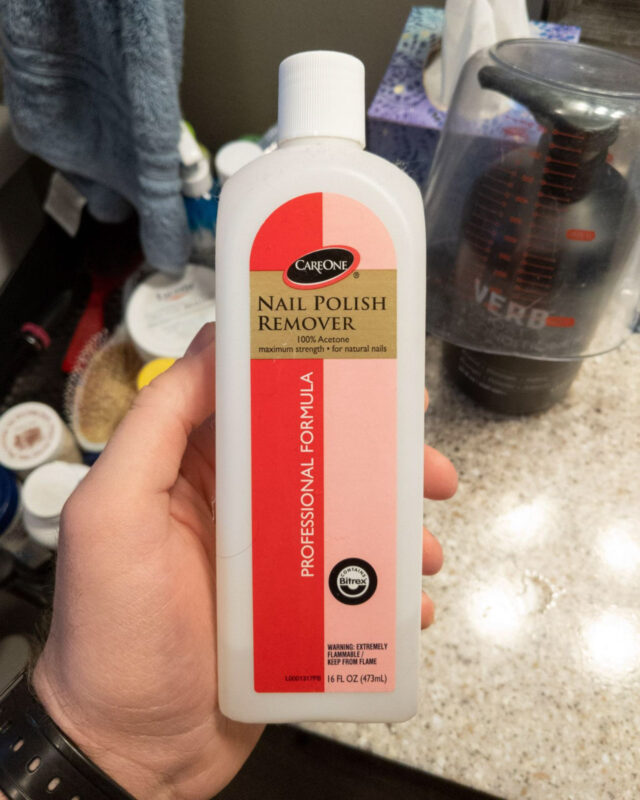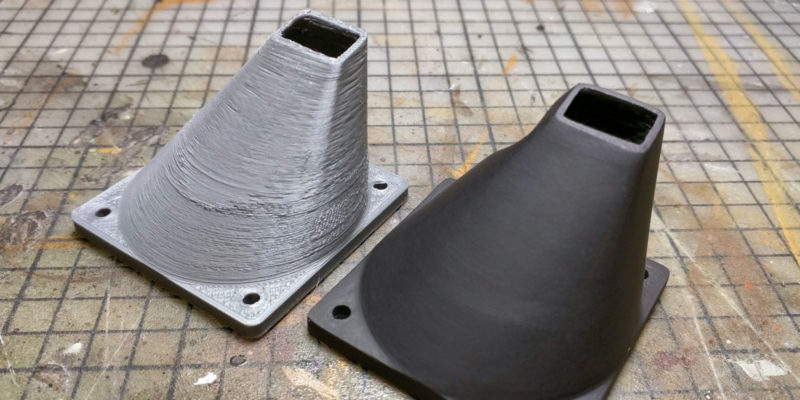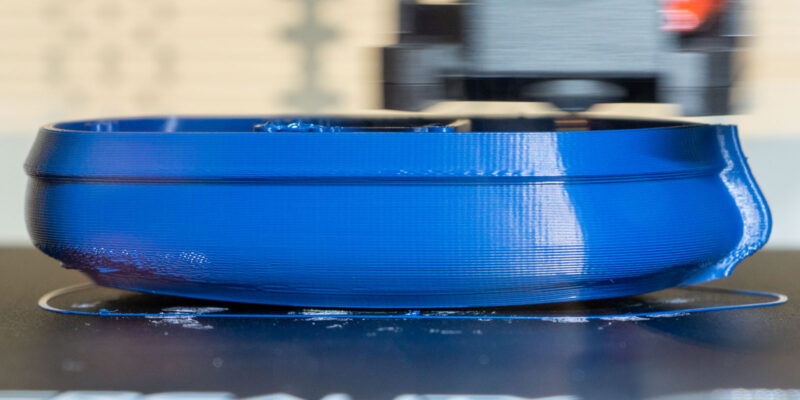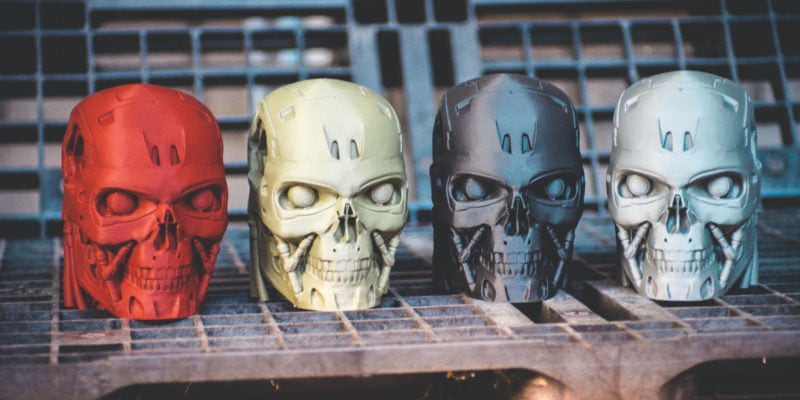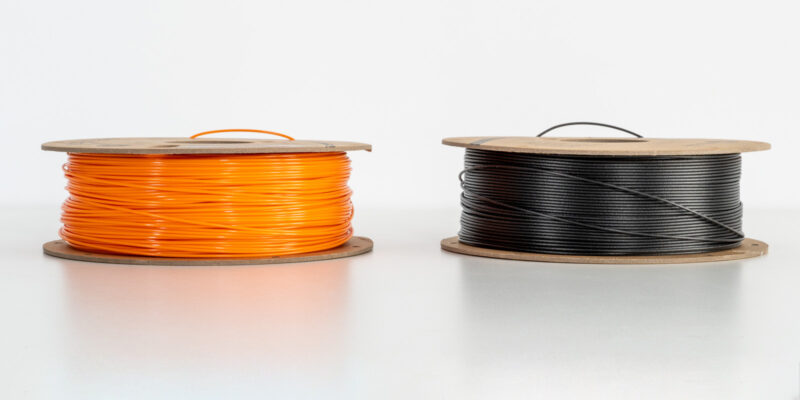Anyone who regularly works with 3D printing materials like PLA or PETG knows what a pain (literally) it is to get smooth and shiny 3D prints from sanding. A medium-sized print can take several hours to sand smooth, which just isn’t feasible for large-scale production.
That’s where ABS comes in. Thanks to its reactivity to acetone, ABS prints can be smoothed quickly and easily (and without all the wrist cramps).
But there is a catch. For all its convenience, ABS acetone smoothing is a dangerous process. It’s important to know what you’re doing before you try it.
We’ll get you caught up on the basics of safely working with acetone, teach you the different techniques for smoothing ABS, and help you figure out which method you should use for your printing needs.
Warning: Understanding the Risks of Vapor Smoothing ABS

While vapor smoothing ABS is popular in the 3D printing community, it is a highly volatile and unsafe process. And though the techniques have evolved over time, even current recommendations come with risks.
Acetone is an eye, skin, and respiratory irritant. The acetone sold in stores is man-made, but acetone is actually a naturally-occurring compound, and you breathe in small amounts of it from the air on a regular basis. Natural levels of exposure aren’t a concern and can usually be safely processed by your liver.
Higher exposure to acetone is more troubling and usually results in acute symptoms like irritation to your eyes, nose, and throat. When you start experiencing these issues, they are an indication that you need to stop what you’re doing immediately to prevent high levels of acetone exposure and the more serious issues that entails.
Even short-term exposure to high levels of acetone can result in symptoms like nausea, dizziness, confusion, changes to your blood cells, loss of consciousness, and coma. Long-term exposure hasn’t been fully studied in humans, but scientists have observed issues like liver damage, kidney damage, birth defects, nerve damage, and male infertility in animals.
Beyond its health risks, acetone is also highly flammable, and you should never heat it. An early suggestion DIYers often recommended was to heat acetone in a kitchen appliance (such as a rice cooker or slow cooker) until it vaporized and suspend 3D prints above the hot liquid.
These acetone steam bath solutions are a massive fire hazard and should not be attempted.
Considering the many risk factors and safety issues, we recommend using a less invasive smoothing technique or investing in a professional acetone vapor chamber if you need to smooth ABS 3D-printed parts regularly. Off-the-shelf vapor chambers can be expensive, but the results are much safer than at-home solutions.
Why Smooth ABS Prints?
Chemically smoothing ABS is an efficient and time-saving way to post-process prints. Whether you dislike the look of layer lines on your print or your part needs a smooth surface to function properly, the acetone smoothing process gives your ABS prints a smooth polished surface without hours of labor-intensive sanding, priming, and painting.
ABS (Acrylonitrile butadiene styrene) is soluble in acetone, meaning that it will dissolve when placed in acetone. This can be done directly in an acetone bath, or by exposing the ABS filament to acetone vapor—hence the name vapor smoothing.
In the acetone smoothing process, ABS prints are exposed to acetone until the outermost layers of plastic melt slightly. This removes visible layer lines from the 3D printing process and gives the part a smooth and glossy look.
While ABS smoothing is good for aesthetic purposes, it also has practical functions as well. Smoothing out the layer lines reduces the number of microscopic gaps on the part’s surface that are typical of 3D-printed parts. This makes them less prone to holding water or bacteria between layers, which can be helpful in certain practical applications.
ABS Smoothing Methods

While there are several different techniques you can use for smoothing ABS with acetone, some are safer than others. So before we cover the various techniques, let’s cover the important safety aspects.
Safety First
- All of the following methods should be done in a well-ventilated area with gloves, goggles or a face shield, long-sleeved clothing, and a respirator.
- You should also be close to a sink to quickly rinse off any areas with accidental skin contact, have an extinguisher and other fire safety equipment nearby, and have a way to quickly remove yourself from the area and into the fresh air in case of acetone fume inhalation.
- Always keep acetone (liquid or vapor) away from open flames, sparks, or other possible ignition sources. Don’t leave vaporized acetone unattended, and keep your liquid acetone in a cool, dry place.
- Since acetone eats through certain types of plastic, it’s best to use glass or metal containers to hold the acetone while smoothing your prints and to put a non-reactive material down to cover and protect your workspace.
Finally, you’ll want to rinse off the acetone from your print once it is smoothed or the acetone will continue to eat away at your part. It’s best to not do this directly in the sink. Use a separate container with water to wash them off.
When your water needs to be refreshed, do not pour it (or your leftover acetone, for that matter) down your drains or into your toilet. It could damage your (often ABS) pipes or your local drainage systems.
Plus, your leftovers will contain some dissolved ABS filament in them, which is not safe to expose to your water supply. Contact your municipality or sewage provider for disposal instructions, since they vary depending on local laws and ordinances.
Brush
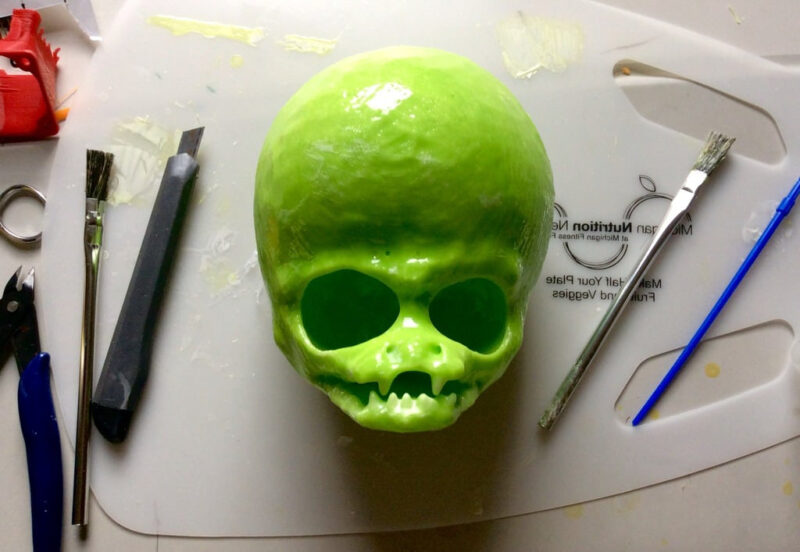
The brush technique is one of the easiest to do for smoothing ABS since it doesn’t require many supplies or special techniques. You are simply brushing liquid acetone onto your ABS print.
The downside is that it’s also one of the most unreliable methods since it is difficult to evenly distribute the acetone on the 3D print’s surface.
Supplies needed
Instructions
- Pour a small amount of acetone into a glass or metal dish.
- Using a soft-bristled brush, quickly paint the surface of your ABS print with the acetone in a thin, even layer.
- Set the 3D print aside and let it sit until the surface has reached your desired level of smoothness.
- Rinse the acetone from the print with water and allow it to dry completely.
Cold Vapor
Cold acetone vapor smoothing uses natural evaporation and condensation cycles to uniformly smooth ABS prints. Because very little acetone actually touches the ABS print, it doesn’t lose as much detail as the brush or bath smoothing methods. This makes it an ideal choice for prints with a lot of fine details or delicate parts.
Supplies needed
Instructions
- Find a lidded container (preferably several times larger than your ABS print) made of glass, metal, or non-reactive plastic. A glass jar works best, as you can peek inside without opening it.
- Wet a few paper towels with acetone until they are just damp.
- Adhere the towels to the sides of your container. How you do this depends on the container you’re using, but wedging one corner under the lid usually works well.
- Place your 3D print in the container, ensuring it doesn’t directly touch the paper towels or the bottom of the container. You can use a secondary container, string, or even a piece of aluminum foil to keep your print elevated and away from direct contact with the acetone.
- Check your print every 10-20 minutes and remove it from the container when it reaches the desired smoothness. If your work area is a bit cold, the smoothing process may take a while.
Vapor Chamber

As we mentioned in the warning section above, while ABS acetone vapour smoothing is the quickest and most convenient method, it is dangerous. You essentially vaporize liquid acetone and give your prints an acetone steam bath.
Many of the early methods for ABS acetone vapour smoothing at home were extremely dangerous, and even the current techniques (cold vapor) still come with the risk of extended exposure to acetone fumes.
Supplies needed
- Pure acetone
- Vapor chamber
Instructions
- Add acetone to the chemical reservoir in your vapor chamber.
- Open the door and place your 3D print(s) on the build plate. If smoothing more than one part at a time, leave at least an inch of space between them to ensure they all get coated evenly.
- Follow your machine’s prompts to start a vapor cycle. This will vary depending on your machine, so always refer to manufacturer instructions first.
- Allow the machine to run its cycle.
- Remove the part from the chamber when finished and rinse off any remaining acetone.
Bath
For a more uniform smoothing than a paintbrush and a safer process than vapor smoothing, an acetone bath is a good compromise. It works by submerging your ABS 3D print in a container of acetone until it reaches the desired smoothness.
Since the bath method works so quickly and aggressively, it requires close supervision to avoid dissolving away too much of your ABS 3D print’s surface layers.
Supplies needed
- Pure acetone
- Non-reactive container
- Wire or string (optional)
Instructions
- Find a glass or metal container that is at least twice the height of your 3D print.
- Fill the container with enough acetone to completely cover your print.
- Fully submerge your print in the acetone and leave it there until it reaches the desired smoothness.
If you would rather not smooth the entire print, use a string or piece of wire to suspend the print in the container and only submerge it as far as you’d like. - Remove your print from the acetone when it’s finished and rinse it off with water.
Can You Sand ABS Instead?
It is possible to forgo chemical smoothing and sand ABS instead to get a smooth surface finish. However, this is a labor-intensive process that can make large or intricate 3D prints difficult to manage.
One of the reasons users choose to work with ABS is because of its ability to be easily smoothed and therefore quicker to post-process. If you’re going to sand your finished 3D print anyway, it might be more worthwhile to use an easier-to-3D-print ABS alternative entirely.
Plus, while sanding is generally considered safer than working with acetone, it still has its associated risks. Sanding plastics creates plastic dust, which can be harmful to your respiratory health when inhaled. So you still need to use a respirator and other protective equipment when sanding.
Can You Smooth ASA With Acetone?
Yes, you can smooth ASA filament (Acrylonitrile styrene acrylate) material with acetone. Like ABS, it is acetone soluble, so it will behave quite similarly to ABS filament in an acetone vapor bath. Other 3D printing materials like HIPS, Polycarbonate, and PMMA also respond well to acetone smoothing.
What About PLA and PETG?
PLA and PETG both have decent chemical resistance and aren’t ketone-soluble. This means that solvents like acetone and alcohol have little to no effect on them.
PLA smoothing especially has been a popular topic in the 3D printing community for years, but any possible chemical equivalents to ABS’s interaction with acetone are too dangerous to use. The most reliable way to smooth PLA and PETG is, unfortunately, by sanding them.
Is It Possible to Use Nail Polish Remover to Smooth ABS?
Some nail polish removers contain acetone, but there is a lot of variation between different brands and products. You can find some ‘pure acetone’ or ‘100% acetone’ products, but most are diluted with other solvents, such as isopropyl alcohol. This makes them less ideal for smoothing ABS prints.
Others use methyl ethyl as a base, and while these are usually marketed as acetone free, it’s best to check the label for the product’s active ingredients.
You can certainly try acetone nail polish removers to smooth ABS prints if you have it on hand or it is the only acetone product easily available to you. Just keep in mind that it may not work as quickly or effectively, and you will most likely get better results from the pure acetone products found in the paint section of your local hardware store.
Does Vapor Smoothing ABS Increase Strength?
Technically, yes. Acetone smoothing your ABS 3D prints can make them stronger. Removing the layer lines and the microscopic gaps between them reduces stress points and the risk of weak spots from layer adhesion issues in your finished print.
However, acetone exposure also temporarily softens the surface layers of the print, and it is slow to reharden. So while you may have more strength in your print in the long run, it can take up to several weeks after ABS vapor smoothing for your treated parts to reach that strength.
How Long Does It Take ABS to Dissolve in Acetone?

How quickly ABS dissolves in acetone depends on a few different factors. For one thing, the temperature of the acetone affects how quickly the ABS filament breaks down in it. Colder temperatures slow down the solubility, while warm (room) temperature acetone breaks down ABS more quickly.
The size of the ABS part is also a factor. Larger and/or thicker prints take more time to dissolve than small prints and may take up to 24 hours to dissolve. If you want to fully dissolve a piece of ABS in acetone, a good rule of thumb is to leave it overnight. Your ABS part will usually be dissolved by morning.
If your ABS isn’t dissolving in acetone or is taking a long time to dissolve, there may be a few reasons for this. If you’ve smoothed or dissolved ABS into the acetone before, there may be too much ABS already in the liquid.
Acetone reaches a saturation point eventually and can’t absorb any more ABS beyond that. Think of when you put too much sugar or salt in a glass of water—the excess crystals float to the bottom of the cup and won’t dissolve. Try using fresh acetone and see if you have better results.
It’s also a good idea to check the strength of your acetone. If you’re using diluted acetone (such as a nail polish remover), it will take longer to dissolve the ABS and may not be able to hold as much dissolved ABS as pure full-strength acetone.
If that still doesn’t work, it’s probably your ABS. Filament manufacturers add dyes, polymers, binders, and all sorts of chemicals to their products to improve their printability. Sometimes this can change the mechanical properties of the base plastic, such as making ABS more resistant to acetone. The best ABS filament brands tend to be more transparent about what they add to their filament.
Can You Smooth ABS in Isopropyl Alcohol?
Not really. The only 3D printing filament isopropyl alcohol has been shown to reliably smooth is PVB (Polysmooth). Isopropyl alcohol is more useful for cleaning dirt, residue, and other debris from your build plate and for washing resin prints.
Is Acetone-Smoothed ABS Food-Safe?
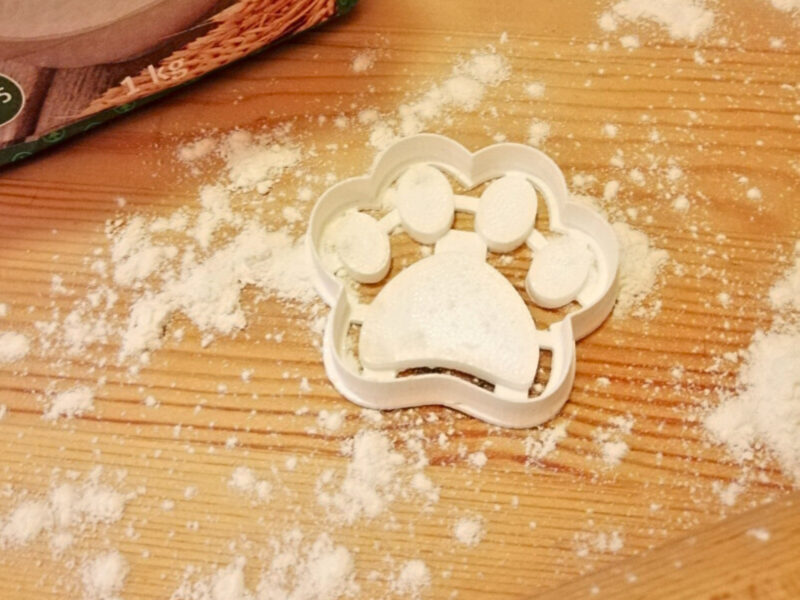
3D-printed ABS filament is not food safe even after acetone smoothing. While bacterial growth between layer lines is one of the bigger food safety concerns surrounding 3D-printed parts, it is not the only concern.
3D printing filaments are hardly ever 100% composed of their base material. They have countless dyes, polymers, and chemicals added to them to change how they look and behave.
Not to mention, they also often have contaminants from either the filament manufacturing process or their journey through your 3D printer. This makes it difficult to say with certainty what a 3D print contains by the time the printing process is complete.
Unless your 3D printer is specifically set up to be sanitary and you use a food-safe ABS filament, it is extremely unlikely that you can classify your ABS prints as food safe.
Final Thoughts on Smoothing ABS
Manually post-processing 3D prints is a chore, but ABS makes it a little easier. Since acetone dissolves ABS filament, you can get smooth and shiny prints by putting them in direct contact with its liquid or vapor form. This makes acetone brushing, vapour, and baths valid options for smoothing ABS.
While ABS acetone smoothing is convenient for smooth and glossy ABS 3D prints, it does pose some pretty significant health and safety hazards. Make sure to wear protective equipment, work in a well-ventilated area, and keep the acetone away from heat and open ignitions.
You’ll also want to make sure that you dispose of the leftovers correctly. None of these materials are suitable to be disposed of in your sink or trash. Only recycling facilities and other specialized disposal services are properly equipped to deal with these types of hazardous waste.
Have you tried ABS acetone smoothing before? Tell us about it in the comments!



